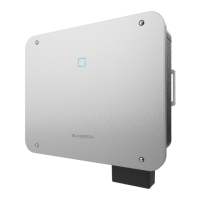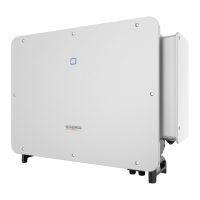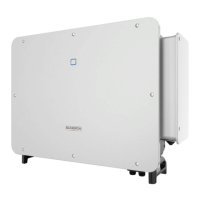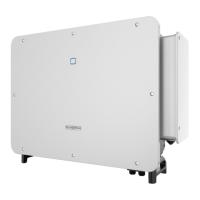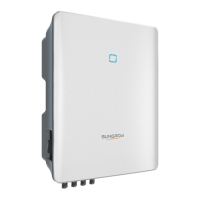Do you have a question about the Sungrow PowerStack-ST535kWh-250kW-2h and is the answer not in the manual?
Identifies the intended audience for this manual, including operators and technical personnel.
Provides guidance on reading and understanding the manual for effective product usage.
Explains safety symbols, hazard warnings, and notes used throughout the manual.
Specifies the qualifications and training required for personnel handling the ESS.
Details critical safety measures related to electrical hazards and high voltage.
Outlines essential safety precautions for handling and operating battery systems.
Provides safety guidelines for lifting and moving the equipment.
Emphasizes safety during the installation and electrical wiring processes.
Covers safety warnings and procedures for operating and maintaining the ESS.
Instructs on the proper and environmentally safe disposal of the product.
Overview of the integrated energy storage system and its applications.
Details the physical appearance and components of the BESS and PCS cabinets.
Illustrates the external features and labeled parts of the BESS cabinet.
Provides key physical dimensions and specifications for BESS and PCS.
Explains the airflow and cooling design for BESS and PCS units.
Describes the internal equipment and layout of the BESS and PCS.
Details the main electrical equipment housed within the BESS and PCS.
Introduces the LFP battery cells, modules, and clusters with their parameters.
Presents information on the SC50HV component, including its appearance.
Highlights important precautions to prevent damage and warranty invalidation.
Describes the approved methods for transporting the energy storage system.
Specifies requirements for safe loading, unloading, and transportation procedures.
Details environmental and physical conditions for storing the ESS.
Explains methods for securing the container to the foundation.
Covers checks for deliverables and product integrity before installation.
Ensures all items listed in the packing list are present.
Checks the received container and internal equipment for damage.
Specifies conditions for the installation site and surrounding environment.
Details site selection criteria considering climate, geology, and ventilation.
Outlines essential criteria for constructing a stable and suitable foundation.
Provides recommended spacing for BESS and PCS for maintenance and dissipation.
Describes the safe use of forklifts for moving the BESS and PCS.
Covers safety precautions and procedures for lifting and moving the equipment.
Highlights safety rules and forbidden zones during hoisting operations.
Details the step-by-step process and requirements for lifting the devices.
Warns about electrical hazards and emphasizes pre-connection checks.
Presents the wiring diagram of the BESS-PCS system.
Covers necessary tools, door opening, and cable preparation steps.
Lists required tools and protective equipment for wiring.
Illustrates the procedure for opening the cabinet door before wiring.
Specifies requirements for cable selection and terminal crimping.
Details the sequence and components for connecting copper cables.
Explains how to connect aluminum wires using adapter terminals.
Describes routes for external cables entering the outdoor cabinets.
Guides the connection of auxiliary power supply to the PCS.
Details connecting power from PCS to the BESS cabinet.
Explains how to connect the 24Vdc power from BESS to PCS and EMS.
Describes how to establish communication links between BESS and PCS.
Covers final checks, sealing, and locking after wiring is completed.
Provides safety precautions and steps for connecting DC cables.
Highlights DC connection safety, including voltage checks and fault handling.
Shows wiring diagrams for BESS-PCS and BESS*2-PCS connections.
Step-by-step guide for connecting DC cables to the BESS.
Step-by-step guide for connecting DC cables to the PCS.
Covers safety precautions and steps for connecting AC cables.
Warns about AC connection hazards and requires utility approval.
Details the procedure for connecting AC cables to the PCS.
Emphasizes safety during battery connection and general system care.
Details tool preparation and the process of connecting battery cables.
Describes the process for safely powering on the ESS after installation.
Lists critical checks required before powering on the system.
Provides sequential steps for powering up PCS and BESS cabinets.
Covers procedures for planned and unplanned system shutdowns.
Details the steps for a controlled shutdown of PCS and BESS.
Outlines actions for emergency shutdowns due to fire or faults.
Guides on connecting to the LC200 via WiFi using a mobile device.
Instructions for changing the WiFi hotspot name (SSID) and settings.
Emphasizes compliance with local fire laws and regular equipment checks.
Describes the aerosol fire suppression system and its detectors.
Explains the function of the exhaust system in response to gas detection.
Details the automatic activation logic of the aerosol fire suppression system.
Provides safety warnings and conditions for performing maintenance.
Outlines maintenance tasks and their recommended frequency.
Specifies inspection items for bi-annual maintenance.
Details annual maintenance checks for internal and external components.
Lists maintenance tasks for semi-annual to annual intervals.
Provides guidance on maintaining the liquid cooling system.
Covers cleaning and inspection of the container's appearance and parts.
Details steps for cleaning the exterior of the container based on condition.
Instructs on checking and lubricating door locks and hinges.
Emphasizes checking sealing strips to prevent water seepage.
Provides guidelines for regular battery maintenance and cycle management.
Outlines recommended maintenance cycles and factors affecting them.
Lists safety requirements for personnel performing maintenance.
Provides specific maintenance actions and operating temperature guidelines.
Specifies the standard, period, and tools for coolant replacement.
Lists technical specifications for BESS and PCS cabinets.
Provides recommended torque values for cable lug connections.
Outlines the warranty service policy for product faults.
Provides contact details and required information for support inquiries.
Identifies the intended audience for this manual, including operators and technical personnel.
Provides guidance on reading and understanding the manual for effective product usage.
Explains safety symbols, hazard warnings, and notes used throughout the manual.
Specifies the qualifications and training required for personnel handling the ESS.
Details critical safety measures related to electrical hazards and high voltage.
Outlines essential safety precautions for handling and operating battery systems.
Provides safety guidelines for lifting and moving the equipment.
Emphasizes safety during the installation and electrical wiring processes.
Covers safety warnings and procedures for operating and maintaining the ESS.
Instructs on the proper and environmentally safe disposal of the product.
Overview of the integrated energy storage system and its applications.
Details the physical appearance and components of the BESS and PCS cabinets.
Illustrates the external features and labeled parts of the BESS cabinet.
Provides key physical dimensions and specifications for BESS and PCS.
Explains the airflow and cooling design for BESS and PCS units.
Describes the internal equipment and layout of the BESS and PCS.
Details the main electrical equipment housed within the BESS and PCS.
Introduces the LFP battery cells, modules, and clusters with their parameters.
Presents information on the SC50HV component, including its appearance.
Highlights important precautions to prevent damage and warranty invalidation.
Describes the approved methods for transporting the energy storage system.
Specifies requirements for safe loading, unloading, and transportation procedures.
Details environmental and physical conditions for storing the ESS.
Explains methods for securing the container to the foundation.
Covers checks for deliverables and product integrity before installation.
Ensures all items listed in the packing list are present.
Checks the received container and internal equipment for damage.
Specifies conditions for the installation site and surrounding environment.
Details site selection criteria considering climate, geology, and ventilation.
Outlines essential criteria for constructing a stable and suitable foundation.
Provides recommended spacing for BESS and PCS for maintenance and dissipation.
Describes the safe use of forklifts for moving the BESS and PCS.
Covers safety precautions and procedures for lifting and moving the equipment.
Highlights safety rules and forbidden zones during hoisting operations.
Details the step-by-step process and requirements for lifting the devices.
Warns about electrical hazards and emphasizes pre-connection checks.
Presents the wiring diagram of the BESS-PCS system.
Covers necessary tools, door opening, and cable preparation steps.
Lists required tools and protective equipment for wiring.
Illustrates the procedure for opening the cabinet door before wiring.
Specifies requirements for cable selection and terminal crimping.
Details the sequence and components for connecting copper cables.
Explains how to connect aluminum wires using adapter terminals.
Describes routes for external cables entering the outdoor cabinets.
Guides the connection of auxiliary power supply to the PCS.
Details connecting power from PCS to the BESS cabinet.
Explains how to connect the 24Vdc power from BESS to PCS and EMS.
Describes how to establish communication links between BESS and PCS.
Covers final checks, sealing, and locking after wiring is completed.
Provides safety precautions and steps for connecting DC cables.
Highlights DC connection safety, including voltage checks and fault handling.
Shows wiring diagrams for BESS-PCS and BESS*2-PCS connections.
Step-by-step guide for connecting DC cables to the BESS.
Step-by-step guide for connecting DC cables to the PCS.
Covers safety precautions and steps for connecting AC cables.
Warns about AC connection hazards and requires utility approval.
Details the procedure for connecting AC cables to the PCS.
Emphasizes safety during battery connection and general system care.
Details tool preparation and the process of connecting battery cables.
Describes the process for safely powering on the ESS after installation.
Lists critical checks required before powering on the system.
Provides sequential steps for powering up PCS and BESS cabinets.
Covers procedures for planned and unplanned system shutdowns.
Details the steps for a controlled shutdown of PCS and BESS.
Outlines actions for emergency shutdowns due to fire or faults.
Guides on connecting to the LC200 via WiFi using a mobile device.
Instructions for changing the WiFi hotspot name (SSID) and settings.
Emphasizes compliance with local fire laws and regular equipment checks.
Describes the aerosol fire suppression system and its detectors.
Explains the function of the exhaust system in response to gas detection.
Details the automatic activation logic of the aerosol fire suppression system.
Provides safety warnings and conditions for performing maintenance.
Outlines maintenance tasks and their recommended frequency.
Specifies inspection items for bi-annual maintenance.
Details annual maintenance checks for internal and external components.
Lists maintenance tasks for semi-annual to annual intervals.
Provides guidance on maintaining the liquid cooling system.
Covers cleaning and inspection of the container's appearance and parts.
Details steps for cleaning the exterior of the container based on condition.
Instructs on checking and lubricating door locks and hinges.
Emphasizes checking sealing strips to prevent water seepage.
Provides guidelines for regular battery maintenance and cycle management.
Outlines recommended maintenance cycles and factors affecting them.
Lists safety requirements for personnel performing maintenance.
Provides specific maintenance actions and operating temperature guidelines.
Specifies the standard, period, and tools for coolant replacement.
Lists technical specifications for BESS and PCS cabinets.
Provides recommended torque values for cable lug connections.
Outlines the warranty service policy for product faults.
Provides contact details and required information for support inquiries.
| Energy Storage Capacity | 535 kWh |
|---|---|
| Power Output | 250 kW |
| Discharge Duration | 2 hours |
| Nominal AC Power | 250 kW |
| Rated Power | 250 kW |
| Energy Capacity | 535 kWh |
| Cooling Method | Air cooling |
| Model | PowerStack ST535kWh-250kW-2h |
| Duration | 2 hours |
| Communication Interface | CAN |

